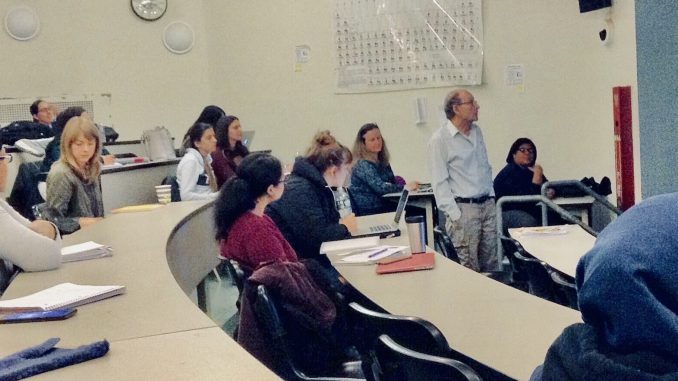
The primary issue at hand, throughout CUNY, is excessive energy consumption. On Tuesday, Nov. 26, Sustainable CUNY Director Tria Case spoke substantially on her program’s efforts in creating clean energy with the BC community.
As stated by Carrie Sadovnik, Chair of BC Sustainability Council and Director of Environmental Health and Safety, CUNY contributes 1% of NYC’s total energy usage. Through BC’s Campus Sustainability 10-Year Master Plan, this environmental hazard and others were addressed through the college’s seven areas for improvement: waste reduction, recycling, energy, water, procurement, transportation, education, and sustainable dining.
25% of BC’s resources go towards waste management and recycling, while about 20% of this plan is dedicated to energy resiliency. The remaining 55% of BC’s Master Plan prioritizes community engagement, academic programs, procurement, sustainable dining, and water usage.

At BC, teachings on energy sustainability have been in effect through classes like Professor Micha Tomkiewicz’s Macaulay Honors Seminar III. Using techniques like visualization and mapping, his students evaluate environmental issues in contemporary NYC.
“What we are trying to do is use the law mandated to make all the colleges and universities better in sustainability, mainly in greenhouse gas emissions and energy use,” mentioned Prof. Tomkiewicz. “This mission will stay and continue.”
In 2017, Whitehead Hall received lighting upgrades to substitute fluorescents for LED technology. Comparatively, LED bulbs are more cost-effective than fluorescent lighting, given its minimal wattage usage. In BC student Tyler Carrero’s video The Seven Pillars of Sustainability, Sadovnik mentioned that this replacement led to “30% savings in energy costs.” Furthermore, to jointly take on the pillars of energy and recycling, BC created its first Leadership in Energy and Environmental Design certified building in 2014: the Leonard & Claire Tow Center for the Performing Arts. The center’s recycled furniture, energy-efficient HVAC systems, and use of natural lighting all contribute to environmental sustainability.
According to the 10-Year Master Plan, with these cuts to unnecessary energy consumption across campus, BC will save approximately $1.5 million in annual energy costs. This accumulation of BC savings can be relocated to the college’s budget, and consequently, be used to support short-term resolutions across campus.
To aid in such efforts, Case and her colleagues established the Sustainability Investment Fund.
“We had an outside funder provide a million dollars to the university for small projects that have quick payback but, have an impact on our carbon footprint,” said Case. However, despite the implementation of this source, Sustainable CUNY’s financial aid is limited to the availability of revolving funds–especially for senior campuses like BC that are mostly state-funded.
“It’s incredibly important to our senior campuses that we [Sustainable CUNY] are being as efficient as possible […] from a budget perspective,” said Case.
On a broader scale, CUNY’s and BC’s focus on energy has contributed to the NYC Solar Partnership movement. In alliance with the Mayor’s Office of Sustainability and NYC Economic Development Corporation, Sustainable CUNY and its collaborators created the NY Solar Map. This accessible tool shows users the potential energy storage of any address in New York State.
With the NY Solar Map and automated building management systems, CUNY schools are equipped to collect data efficiently. For nearly five years, BC has deployed a real-time system that informs personnel of needed adjustments and fixes around campus. Through data analyses and overnight walk-ins, Case and her crew found that several colleges had high electricity consumption day-round. Though CUNY colleges are nearly empty during nighttime, lights and HVAC systems were still running. “Everybody thought that everything was shut down,” said Case.
Through the communal efforts of BC and other CUNY schools alike, hopes for institutionalizing sustainability has become more tangible under Sustainable CUNY’s and its project-based movement. “We were not driven by energy efficiency. We were not driven by the energy budget. We were not driven by carbon footprint reduction,” said Case. “We were driven by educating students. That’s our primary objective.”
